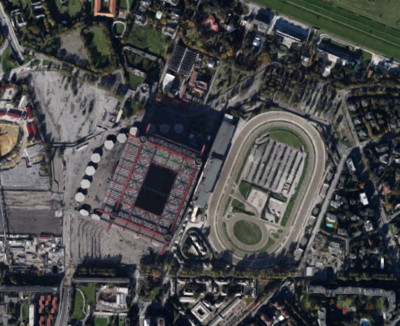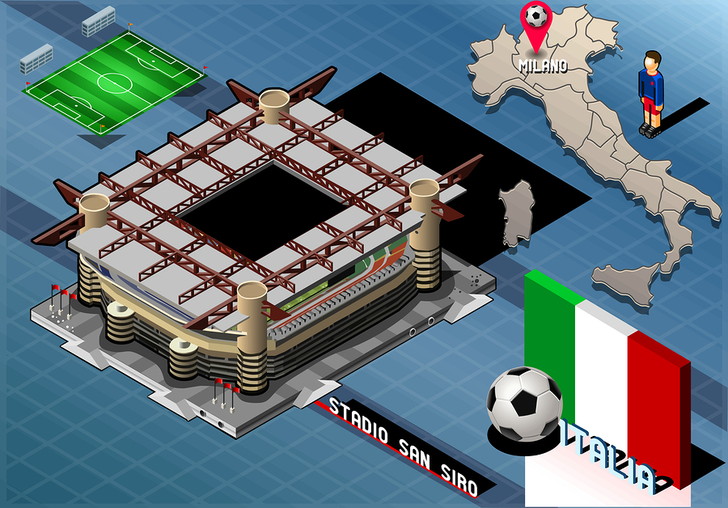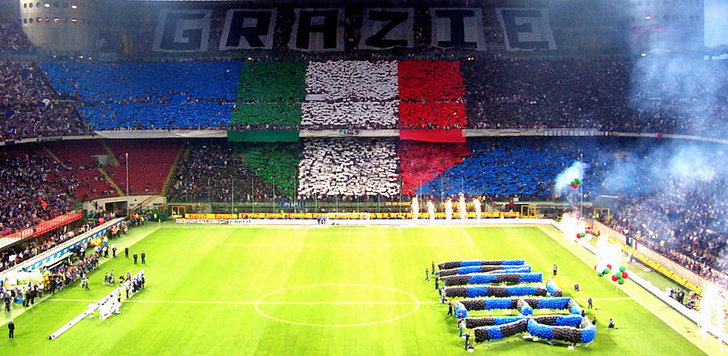 The capital of the administrative region of Lombardy and the second-most populated city in Italy, Milan has long been considered to be the fashion capital of the world. As well as hosting events such as Milan Fashion Week and the Milan Furniture Fair, the city has the fifth most Michelin starred restaurants in the entire world.
The capital of the administrative region of Lombardy and the second-most populated city in Italy, Milan has long been considered to be the fashion capital of the world. As well as hosting events such as Milan Fashion Week and the Milan Furniture Fair, the city has the fifth most Michelin starred restaurants in the entire world.
Visited by more than eight million people a year, the population of the Metropolitan City of Milan stands at around 5.2 million, which makes it the fifth most populous city in the European Union. Add to all of that the countless museums that host works by the likes of Leonardo da Vinci and you can see exactly why Milan is known for more than just its football teams.
that being said, of course, Milan is known for its football teams. Yet the thing that makes the city stick out from other cities with more than one football club located within their borders isn’t the fact that the two clubs are both successful, it’s that they share the same stadium. It’s an impressive stadium too, though that shouldn’t really be a surprise when you consider the incredible architecture that Milan has within its borders.
From Milan Cathedral, which is the largest Gothic cathedral in the world, through to Neoclassical wonder that is the Villa Belgiojoso Bonaparte, Milan is one of the most visually spectacular cities that you’re likely to come across. Little wonder, then, that the Stadio Giuseppe Meazza is considered to be more than just a football ground. Here’s a look at it, as well as the two clubs that it houses:
{module Maps – Cities – Milan}
Football Stadiums in Milan
| Stadium | Capacity | Team | League |
|---|---|---|---|
| San Siro | 80,018 | AC Milan & Inter Milan | Serie A |
AC Milan – Stadio Giuseppe Meazza (3.40 Miles to The Duomo di Milano)

Associazione Calcio Milan, to give the club its proper name, was founded on the thirteen of December in 1899 by two English expats named Alfred Edwards and Herbert Kilpin. Back then it was known as Milan Foot-Ball and Cricket Club and has forever maintained the English spelling of ‘Milan’, rather than changing to the Italian spelling of ‘Milano’. Though AC Milan is the second-most successful club in Italy in terms of domestic titles, they are considered to be the fourth-most successful club in world football in terms of the international trophies that they have won. At the time of writing they boast seven European Cup titles, five UEFA Super Cups, two Cup Winners’ Cup, three Intercontinental Cups and one FIFA Club World Cup, giving them a total of eighteen trophies that are officially recognised by both UEFA and FIFA.
Away from the football, Milan is perhaps best-known for once being owned by the media tycoon and one-time Prime Minister of Italy Silvio Berlusconi. Though he would later become a controversial figure for any number of reasons, Berlusconi is seen as the man that rescued AC Milan when he bought the club on the twentieth of February in 1986. He rescued it from going bankrupt and and invested money acquiring players like Ruud Gullit, Marco van Basten and Frank Rijkaard. Within two years of the Italian playboy’s arrival, AC Milan had won its first European Cup for more than twenty years when the club best Steaua București 4-0 in the competition’s final. They made it to the final the following year and beat Benfica 1-0, earning the nickname ‘The Immortals’ from the Italian press for their incredible achievement in the 1989–90 season.
The club’s main nickname is the ‘Rossoneri’, which means ‘red & blacks’ in Italian. That’s because of their kit, which is made up of vertical stripes of red and back. The red is supposed to represent the ‘fiery ardor’ of the players, whilst the black is their to represent the fear of their opponents. The colours of the kit have also led the club to be referred to as ‘The Devils’, which might well have been an appropriate name in the wake of the Calciopoli scandal that the club was caught up in. Though a police enquiry decided that no AC Milan manager or player was guilty of match fixing, the Italian Football Federation believed that the club’s Vice-President, Adriano Galliani, was guilty of it and a fifteen point deduction was issued. This would have seen them miss out on participation in the Champions League in 2006-2007 but was later reduced to eight points, allowing them to take part in Europe’s premier club competition.
It was just as well that the Rossoneri were allowed to take part in the European Cup in 2007, given that they went on to win it. They gained revenge over Liverpool, who they had played against in the final two years earlier. It’s impossible to mention AC Milan and the European Cup without giving a quick nod to the ‘Miracle in Istanbul’; though it’s unlikely that the Milan side will have seen it as a ‘Miracle’. The Italian team, known for its defensive ability, went 3-0 up before the half-time whistle. The game was as good as over – or so they thought. The English side scored three goals in the second-half, taking the match the extra-time before winning their fifth European Cup on penalties. It is considered to be the greatest Champions League final of all time and one of the greatest football matches ever.
Moving back to the Stadio Giuseppe Meazza, you might wonder why you don’t recognise the stadium’s name. It’s almost certainly because it’s better known by another name – the San Siro. San Siro isn’t actually the name of the ground, however, but rather the local area in which the stadium was built back in 1926 thanks to private funding from Piero Pirelli, the club’s President at the time. One-hundred and twenty workers spent thirteen-and-a-half months building it, with the club owning it until 1937 when it was sold to the city council of Milan. The club played its first game in the ground on the nineteenth of September in 1926, ironically losing a friendly game 6-3 to Internazionale, their city neighbours who would come to join them in using the stadium from 1947 onwards. Which feels like the perfect time to talk about them…
Inter Milan – Stadio Giuseppe Meazza (3.40 Miles to The Duomo di Milano)

In quite a number of cities where there are two football clubs, one of them tends to live in the shadow of the other. The aforementioned Liverpool, for example, have won double the amount of domestic titles than their city rivals Everton. Likewise Atlético Madrid have picked up ten La Liga titles compared to Real Madrid’s thirty-three and counting. Yet in Milan things aren’t quite so stark in terms of the difference between the city’s two big clubs. At the time of writing, they’ve both won the same number of Serie A titles, eighteen, whilst Inter have won seven Coppa Italias compared to AC’s five. AC have won the Champions League seven times, whilst Inter have won it on three occasions, but Inter have picked up three UEFA Cups and the Rossoneri have won it twice. In other words, there’s not an awful lot to separate them in terms of on-field success.
What does separate the two teams, then? One of the original differences between the two sides came in the form of the type of supporter that they each attracted. AC Milan was always seen as the football club that was supported by the working-class people of the city, whilst Football Club Internazionale Milano, to give it its full title, was the team for the middle-classes that were more prosperous. That was in part because the more ardent AC Milan fans, or Ultras, were considered by the press to be left-wing leaning in their political views and Inter’s Ultras were right-wing. It’s part of the reason why there have regularly been clashes between the two sets of supporters whenever the Derby della Madonnina has come about. Also known as the Derby di Milano, it’s played at least twice a year and has regularly caused problems within the city when it’s taken place. One of the most notable occasions was in the quarter-finals of the Champions League in 2004-2005, when the second-leg of the tie had to be abandoned when a flare hit AC Milan’s goalkeeper Dida on the shoulder.
All of that is something of a far cry from the club’s original beginnings. Football Club Internazionale was formed in 1908 when a schism formed amongst those in charge of AC Milan over the signing of foreign players. AC didn’t want to allow people from outside of Italy to play for the club, with the members that formed Inter disagreeing. The name of the club signifies that, given that ‘Internazionale’ literally translates into ‘International’. When the new club was formed on the ninth of March in 1908 they said, “This wonderful night bestows us with the colours of our crest: black and azure against a gilded backdrop of stars. It shall be called International, because we are brothers of the world”. During Benito Mussolini’s fascist reign of Italy Inter was forced to merge with Unione Sportiva Milanese, a small club in the city, and was given the new name of Società Sportiva Ambrosiana. The club became Football Club Internazionale Milano once again in 1967.
Inter’s nickname is the Nerazzurri, based on the black and blue colour of their kit. During the same period that they had to change their name because it made Italy’s fascist regime uncomfortable they also had to change their kit to a white shirt emblazoned with a red cross, which was essentially the flag of Milan. They reverted back to the black & blue from their foundation when Italy lost the war and the fascists were no longer in charge. To this day they continue to use the red cross on their away shirts, however, as a reminder of this moment in the club’s history. In Italy it’s common for football clubs to be represented by an animal and Inter have the honour of being represented by a grass snake. This might not seem all that honourable, but it’s important in Milan as it was on the coat of arms of the House of Sforza, the family that ruled over the city during the Renaissance period.
When the club was first formed it played its games at the Arena Civica. A visually spectacular example of neoclassical architecture, the venue is mostly used nowadays for rugby and some football matches. In 1947 Inter were accepted as joint-tenants on the building by the city council, who bought it from AC Milan ten years earlier. It was a somewhat suitable venue for the Nerazzurri to move to, given that they beat their city rivals 6-3 in a friendly match their to officially open it on the nineteenth of September in 1926. Unlike the majority of football grounds used by Serie A clubs, which are multipurpose, the San Siro was specifically built to be used as a location for football above any other sport. Originally named the Nuovo Stadio Calcistico San Siroamed, it was renamed in 1980 after Giuseppe Meazza, the former player that played for both AC Milan and Internazionale. It had room for 35,000 people when it first opened but nowadays it can host over 80,000 spectators. Milan might be better known for its fashion, but few stadiums in world football are so imposing and yet have hosted two top-class rival sides for most of their existence.
